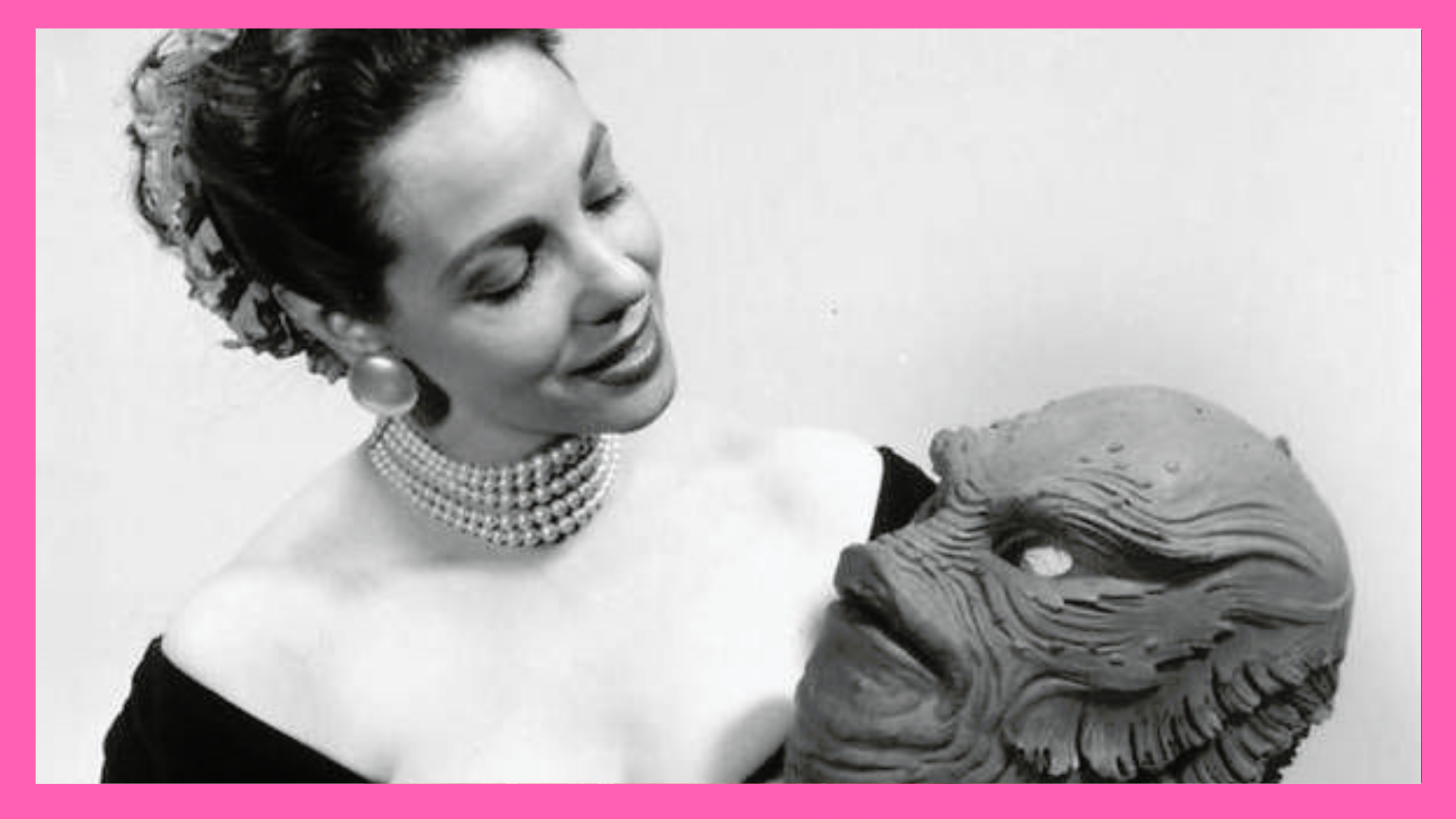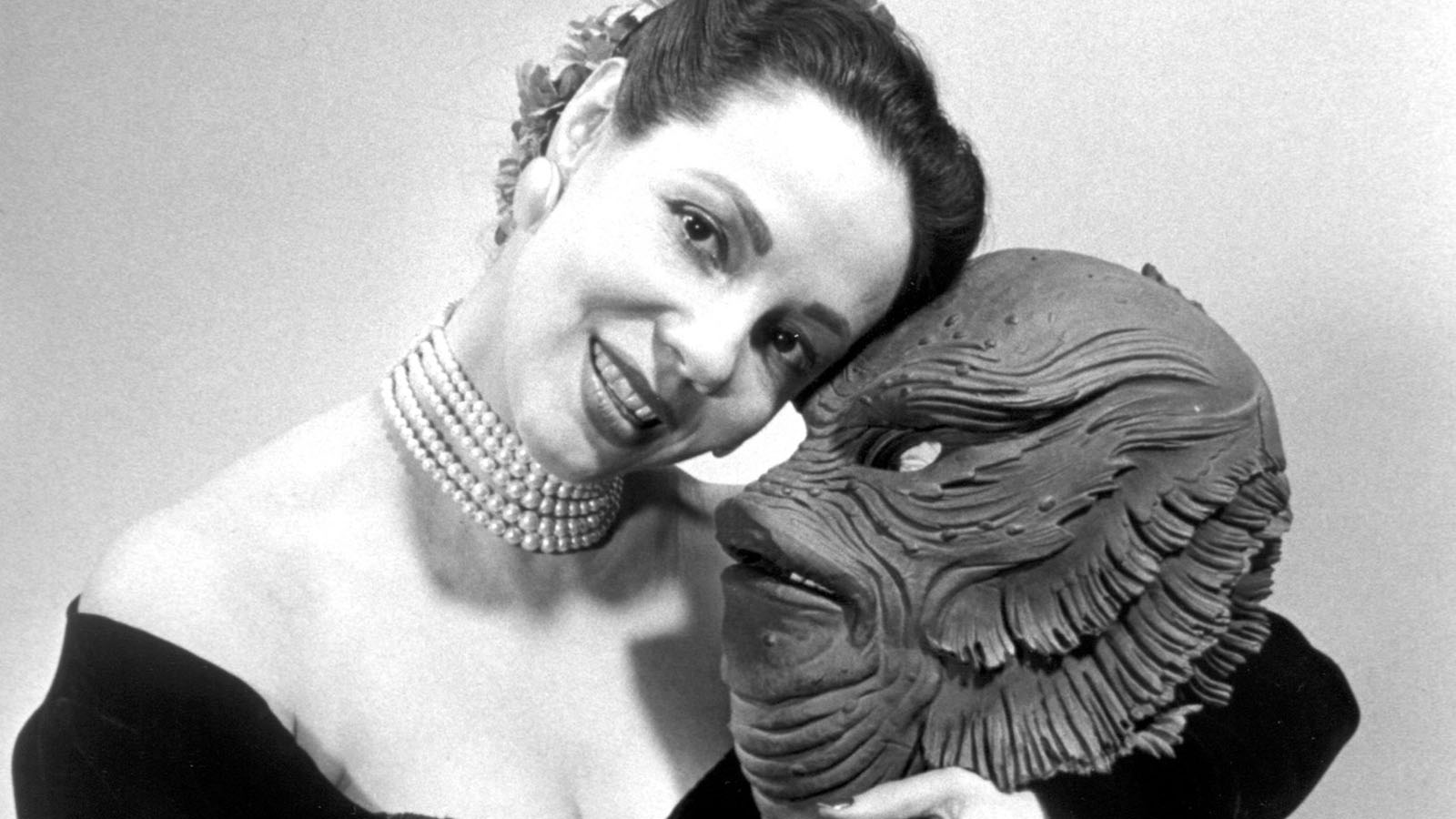[Editorial] Hearts of Darkness: Beauty Creating the Beast – A Posthumous Love Letter to Milicent Patrick
Creature from the Black Lagoon is a 1954 classic monster horror from Universal Studios. The creature struck fear into the hearts of audiences across America, swimming beneath the watery depths, stalking his beautiful prey, and has been the inspiration for many movies since, including the 2017 Best Picture Oscar winner The Shape of Water. The original 1950s monster, the Gill-man, was designed by Milicent Patrick. Haven’t heard of her? I’m not surprised, her career is, to this day, Hollywood’s dirty little secret. The idea that a woman could possibly have the creative skill to draw up such a dark, evil monster was apparently so scandalous at the time that her head of department, Bud Westmore, demanded that all credit go to him.
Milicent sketching The Gill-man for publicity shots.
Born Mildred Elizabeth Fulvia di Rossi in November 1915, Milicent changed her name many times throughout her life, making her career timeline quite a difficult one to follow. What is known however, is that she studied at the Chouinard Art Institute on three scholarships, before joining the Ink and Paint department at Walt Disney Studios. During her time there, Milicent was promoted to Colour Animator, becoming one of the first female animators at the studio, and working on films like Dumbo. Her first dip into the horror genre also happened at Disney, Milicent worked on four separate sequences for 1940’s Fantasia, including the terrifying Night on Bald Mountain, where she created spooky pastel animation for the dreaded Chernabog. As the demon rises over a small town, white skeletons can be seen floating through the sky; the dead return to wreak havoc. The demonic Chernabog folds his arms in triumph with flashes of lightning streaking his features. All these things can be credited to Milicent and the team she was a part of.
After leaving Disney during the animator strikes, Milicent moved on to modelling for companies selling jewellery, cars, and much more due to her classic beauty and charm, but could also be found on-screen in multiple small roles in film and television. Most of these were uncredited, but it gave her a chance to be on set, where she continued to hone her artistic skills by sketching her co-stars and freelancing with illustration.
Milicent working on the Gill-man on the set of Creature from the Black Lagoon.
Eventually, on the lot of Universal studios, Milicent met Bud Westmore, the then head of Universal’s Makeup Department, who employed her as a Makeup Designer, primarily for Creature from the Black Lagoon. Her designs for the monster were a roaring success amongst those who worked on the film. Seeing Milicent as a novelty, a woman designing a horror monster was unheard of, the publicity team decided to send her on a tour of the US to promote the film. This ‘Beauty Who Created the Beast’ tour included a collection of various Universal movie monsters, including those Milicent had assisted with, showing off her true talent and prestige in her field. This didn’t go down well with Bud, who, as the head of the department, was enraged that a woman would be taking credit for ‘his work’ (this was simply not true, Bud had supervised but never designed for Creature from the Black Lagoon). The tour’s tagline was changed to ‘The Beauty who Lives with the Beasts’, taking away all official credit from Milicent, but again, this wasn’t enough for Bud. Her name was removed from the movie’s credits pre-release, and on her return from the tour, Milicent found that she no longer had a job at Universal. The woman who had worked tirelessly to excel in a world of men faded into obscurity, her work forgotten by many.
Milicent Patrick and Bud Westmore, who will forever be known as the petty man who got Milicent fired because he couldn’t accept that her talents were responsible for the creation of the Gill-man.
Before her death in 1998, Milicent never officially received credit for her work. Her time in Hollywood was only remembered by a small number of die-hard fans who fought tirelessly to have her talent honoured, to no avail.
This wasn’t the only disrespect that Milicent received during her artistic career. The apparent ‘golden age of cinema’ and beyond was rife with sexism and harassment, something that Milicent was a victim of almost daily. A memo from her press tour for Creature shows the damage to her wardrobe, something that seems quite sinister when you read the details:
“One cocktail dress—completely ruined.
One cocktail dress—beading broken and lost.
One gabardine suit—shrunk and can’t be repaired.
One lace coat—burned, torn, and shrunk—ruined beyond repair.
One afternoon dress—torn but repairable.
One pair of earrings—cut in half by pub. man and stones lost.
One velvet blouse—torn, can be repaired.”
The fact that so many of her garments were torn (or in one instance burned) raises many red flags today, something that was most likely ignored back then. It has also been noted that Milicent often received unwanted sexual advances from colleagues at work, during her time at Disney, Walt himself told the men to start acting more ‘gentlemanly’ around the women in the office, who were often treated as pieces of meat that could be ogled rather than fellow artists.
In modern day, I would like to say that the media industry has changed, that a woman can enter the arts and not be fearful of detrimental comments, of assumptions of inability due to her gender, or of unwanted sexual advances. Unfortunately, I cannot confirm any of this. When I’m not writing reviews and think pieces for Ghouls, I work in factual television. This is not quite the world of art and design that Milicent was a part of, but the industry itself is a very large blanket that covers multiple roles. I have personally witnessed, and been subjected to cases of sexism and harassment in my career. As a pansexual woman in her late twenties, I have learnt to grow a thick skin, but as a person who suffers from anxiety and imposter syndrome, this kind of behaviour sticks with you like a bad smell. And it isn’t just me, you just need to look at shitmenintvhavesaidtome on Instagram to see examples that have happened to so many other women.
After Milicent’s passing, the recognition of her work has become a lot more public, but not to the degree that she deserves. She was a true pioneer of her time, crashing through gender boundaries to win over everyone who worked with her (except Bud) with not only her charm and appearance (yes she was beautiful, no it was not why she was good at her job), but with the unquestionable talent that she had. Although the sexist tendencies of the creative industries haven’t improved enough, there are more opportunities for women in the media now, which I believe are due to people like Milicent who pushed the boundaries of their era and expanded on the potential for creativity.
For more of Milicent’s story and how it impacted a horror producer of the modern day, check out The Lady from the Black Lagoon: Hollywood Monsters and the Lost Legacy of Milicent Patrick by Mallory O’Meara. Also take a look at Ink & Paint: The Women of Walt Disney’s Animation by Mindy Johnson for more details on the women who turned the tables in the early years of Walt Disney Studios.







![[Editorial] 5 Slasher Short Horror Films](https://images.squarespace-cdn.com/content/v1/5fe76a518d20536a3fbd7246/1696358009946-N8MEV989O1PAHUYYMAWK/Screenshot+2023-10-03+at+19.33.19.png)
![[Ghouls Podcast] Maniac (2012) with Zoë Rose Smith and Iona Smith](https://images.squarespace-cdn.com/content/v1/5fe76a518d20536a3fbd7246/1696356006789-NYTG9N3IXCW9ZTIJPLX2/maniac.jpg)
![[Editorial] If Looks Could Kill: Tom Savini’s Practical Effects in Maniac (1980)](https://images.squarespace-cdn.com/content/v1/5fe76a518d20536a3fbd7246/1694952175495-WTKWRE3TYDARDJCJBO9V/Screenshot+2023-09-17+at+12.57.55.png)
![[Editorial] Deeper Cuts: 13 Non-Typical Slashers](https://images.squarespace-cdn.com/content/v1/5fe76a518d20536a3fbd7246/1694951568990-C37K3Z3TZ5SZFIF7GCGY/Curtains-1983-Lesleh-Donaldson.jpg)
![[Editorial] Editor’s Note: Making a slash back into September](https://images.squarespace-cdn.com/content/v1/5fe76a518d20536a3fbd7246/1694354202849-UZE538XIF4KW0KHCNTWS/MV5BMTk0NTk2Mzg1Ml5BMl5BanBnXkFtZTcwMDU2NTA4Nw%40%40._V1_.jpg)
![[Editorial] 8 Mind Horror Short films](https://images.squarespace-cdn.com/content/v1/5fe76a518d20536a3fbd7246/1693504844681-VPU4QKVYC159AA81EPOW/Screenshot+2023-08-31+at+19.00.36.png)
![[Editorial] Eat Shit and Die: Watching The Human Centipede (2009) in Post-Roe America ](https://images.squarespace-cdn.com/content/v1/5fe76a518d20536a3fbd7246/1691245606758-4W9NZWE9VZPRV697KH5U/human_centipede_first_sequence.original.jpg)
![[Editorial] Top 15 Female-Focused Mind Horror Films](https://images.squarespace-cdn.com/content/v1/5fe76a518d20536a3fbd7246/1691247166903-S47IBEG7M69QXXGDCJBO/Image+5.jpg)
![[Editorial] 8 Body Horror Short films](https://images.squarespace-cdn.com/content/v1/5fe76a518d20536a3fbd7246/1690838270920-HWA5RSA57QYXJ5Y8RT2X/Screenshot+2023-07-31+at+22.16.28.png)
![[Editorial] Metal Heart: Body Dysmorphia As A Battle Ground In Tetsuo: The Iron Man (1989)](https://images.squarespace-cdn.com/content/v1/5fe76a518d20536a3fbd7246/1690190127461-X6NOJRAALKNRZY689B1K/Screenshot+2023-07-24+at+10.08.27.png)
![[Editorial] Top 15 Female-Focused Body Horror Films](https://images.squarespace-cdn.com/content/v1/5fe76a518d20536a3fbd7246/1689081174887-XXNGKBISKLR0QR2HDPA7/download.jpeg)

![[Editorial] In Her Eyes: Tasya Vos in Possessor (2020)](https://images.squarespace-cdn.com/content/v1/5fe76a518d20536a3fbd7246/1667061747115-NTIJ7V5H2ULIEIF32GD0/Image+1+%285%29.jpg)
![[Editorial] In Her Eyes: Sara Lowes in Witchfinder General (1968)](https://images.squarespace-cdn.com/content/v1/5fe76a518d20536a3fbd7246/1655655953171-8K41IZ1LXSR2YMKD7DW6/hilary-heath.jpeg)
![[Editorial] The Babadook (2014)](https://images.squarespace-cdn.com/content/v1/5fe76a518d20536a3fbd7246/1651937631847-KR77SQHST1EJO2729G7A/Image+1.jpg)
![[Editorial] In Her Eyes: Helen Lyle in Candyman (1992)](https://images.squarespace-cdn.com/content/v1/5fe76a518d20536a3fbd7246/1649586854587-DSTKM28SSHB821NEY7AT/image1.jpg)
![[Editorial] Lorraine Warren’s Clairvoyant Gift](https://images.squarespace-cdn.com/content/v1/5fe76a518d20536a3fbd7246/1648576580495-0O40265VK7RN03R515UO/Image+1+%281%29.jpg)
![[Editorial] Sara in Creep 2 (2017)](https://images.squarespace-cdn.com/content/v1/5fe76a518d20536a3fbd7246/1646478850646-1LMY555QYGCM1GEXPZYM/27ebc013-d50a-4b5c-ad9c-8f8a9d07dc93.jpg)
![[Editorial] Sally Hardesty in The Texas Chainsaw Massacre (1974)](https://images.squarespace-cdn.com/content/v1/5fe76a518d20536a3fbd7246/1637247162929-519YCRBQL6LWXXAS8293/the-texas-chainsaw-final-girl-1626988801.jpeg)
![[Editorial] Margaret Robinson: Hammer’s Puppeteer](https://images.squarespace-cdn.com/content/v1/5fe76a518d20536a3fbd7246/1630075489815-33JJN9LSGGKSQ68IGJ9H/MV5BMjAxMDcwNDI2Nl5BMl5BanBnXkFtZTcwOTMxODgzMQ%40%40._V1_.jpg)
![[Editorial] Re-assessing The Exorcist: Religion, Abuse, and The Rise of the Feminist Mother.](https://images.squarespace-cdn.com/content/v1/5fe76a518d20536a3fbd7246/1629995626135-T5K61DZVA1WN50K8ULID/image2.jpg)
![[Editorial] Unravelling Mitzi Peirone’s Braid (2018)](https://images.squarespace-cdn.com/content/v1/5fe76a518d20536a3fbd7246/1628359114427-5V6LFNRNV6SD81PUDQJZ/4.jpg)
![[Editorial] American Psycho (2000)](https://images.squarespace-cdn.com/content/v1/5fe76a518d20536a3fbd7246/1627317891364-H9UTOP2DCGREDKOO7BYY/american-psycho-bale-1170x585.jpg)






















![[Editorial] 10 Films & Events to Catch at Soho Horror Film Fest 2023](https://images.squarespace-cdn.com/content/v1/5fe76a518d20536a3fbd7246/1700819417135-299R7L4P0B676AD3RO1X/Screenshot+2023-11-24+at+09.41.52.png)
![[Editorial] 9 Horror Nintendo Switch Games To Play](https://images.squarespace-cdn.com/content/v1/5fe76a518d20536a3fbd7246/1697214470057-3XZXX8N4LYIMDFWS6Z3P/Screenshot+2023-10-13+at+17.20.13.png)
![[Mother of Fears] Mothering in Silence in A Quiet Place (2018)](https://images.squarespace-cdn.com/content/v1/5fe76a518d20536a3fbd7246/1696445921315-HZJ2DZYQIH6VVWXBO2YL/Screenshot+2023-10-04+at+19.52.29.png)
![[Editorial] 5 Female Focused Horror Book Recommendations](https://images.squarespace-cdn.com/content/v1/5fe76a518d20536a3fbd7246/1696441981361-52EQCTJ7AT2QF1927GM7/919xtm6d3fL._AC_UF894%2C1000_QL80_.jpg)
![[Editorial] 9 Best Slashers Released Within 10 Years of Scream (1996)](https://images.squarespace-cdn.com/content/v1/5fe76a518d20536a3fbd7246/1695478839037-LOFHGVM3H6BMSZW7G83M/Screenshot+2023-09-23+at+15.15.11.png)
![[Mother of Fears] Mother Vs. Monster in Silent Hill (2006)](https://images.squarespace-cdn.com/content/v1/5fe76a518d20536a3fbd7246/1695485781119-H6GNP0G3J2TLPAOIABV7/Screenshot+2023-09-23+at+17.11.56.png)
![[Editorial] 9 Terrifying Cerebral Visions in Horror Movies](https://images.squarespace-cdn.com/content/v1/5fe76a518d20536a3fbd7246/1693509801235-X23OL50T1DVGECH0ZJK2/MV5BMjQ0MTg2MjQ4MV5BMl5BanBnXkFtZTgwMTU3NDgxMTI%40._V1_.jpg)
![[Mother of Fears] I Don’t Wanna Be Buried in a Pet Sematary (1989) and (2019)](https://images.squarespace-cdn.com/content/v1/5fe76a518d20536a3fbd7246/1691328766069-QFNAVJOMFZVZ5CLU1RWM/Screenshot+2023-08-06+at+14.23.13.png)

I can sometimes go months without having a panic attack. Unfortunately, this means that when they do happen, they often feel like they come out of nowhere. They can come on so fast and hard it’s like being hit by a bus, my breath escapes my body, and I can’t get it back.